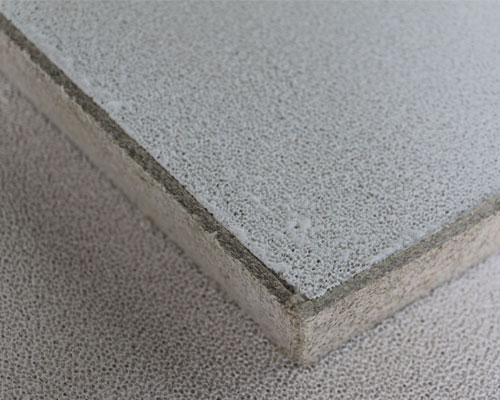The ceramic porous foam filter is an open-cell mesh with a sponge-like structure for filtering aluminum melt. It has been widely used worldwide. A ceramic porous foam filter is a filtering device that uses foam ceramic as the filter medium. The ceramic foam filter is installed in the filter box between the static furnace and the casting table. The molten aluminum flows from the static furnace to the crystallizer after being filtered by the filter box.
The flow characteristics of ceramic foam depend on the pore characteristics and the size of the ceramic plate. For a foam ceramic filter board with a size of 305mm×305mn×51mm and a number of holes of 30 holes/in, the filtration rate is 173.0kg/s. When filtering aluminum melt, the main filtration parameters of ceramic foam are filtration accuracy of 2um, filtration efficiency of 99%, initial pressure head of 50-150mm, and effective working pressure head of 50mm.
Foam ceramic filters have the advantages of high filtration accuracy, high filtration efficiency, lightweight, small footprint, convenient operation, and use, and good working conditions. However, the foam ceramics are discarded once used and cannot be regenerated, and the texture is relatively brittle, so the mixing of fragments should be avoided during installation.
CFF filtration equipment adopts the principle of deep filtration. The ceramic foam filter is a porous medium, and the molten aluminum flows in this medium according to the set route. In order to avoid the second pollution caused by the oxide layer, the movement in the gap is a layered trajectory. Particles are blocked by four methods: direct interception, inertial force, Brownian motion, and gravitational force. The impurities are gradually absorbed by the wall and gradually block the filter layer. The filtration efficiency increases with the increase of inclusion particle size and filter thickness and decreases with the increase of pore size and metal flow rate.

Pay attention to the following issues when using ceramic foam filters in production:
Choose the appropriate ceramic foam filter. When choosing a ceramic foam filter, first consider the requirements for filtration accuracy. In most cases, choosing a ceramic foam filter with 30 holes/in is satisfactory. If the metal is particularly dirty, a 20-hole/in ceramic foam filter can be used for pre-filtering to prevent premature clogging of the 30-hole/in ceramic foam filter. However, in actual production, there are also 40-50 holes/in for products with higher requirements. Secondly, consideration should be given to the flow rate of liquid aluminum in a unit hour required for the casting speed, the original cleanliness of the melt, the highest content of inclusions in the metal, and the total throughput of the metal.
Install the ceramic foam filter correctly. Generally, the ceramic foam filters are arranged horizontally in the filter box, allowing the aluminum water to pass vertically downwards. When the lower casting method is adopted, it has the advantages of the uniform rise of the aluminum water, no turbulence when it hits the filter can ensure the uniform start of the filter, and reducing the danger of channeling. In addition, when installing foam ceramics, the assembly part must be sealed with refractory fibers to eliminate the possibility of any bypass.
Before filtering, it is better to heat the ceramic foam filter to a temperature close to the melt temperature to ensure that when the aluminum liquid flows into the ceramic foam filter, no metal solidifies and blocks the holes.

